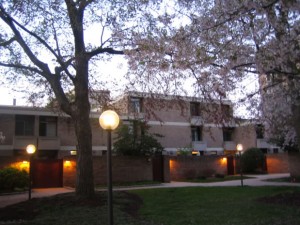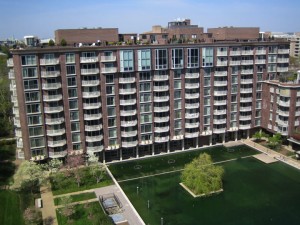 The D.C. Historic Preservation Review Board voted on May 24 to approve Tiber Island’s application for historic designation.
The D.C. Historic Preservation Review Board voted on May 24 to approve Tiber Island’s application for historic designation.
 As a historic landmark, Tiber Island is now included in the District of Columbia Inventory of Historic Sites. The Board further recommended that Tiber Island’s nomination be forwarded to the National Register of Historic Places with a recommendation for listing at the national level of significance.
As a historic landmark, Tiber Island is now included in the District of Columbia Inventory of Historic Sites. The Board further recommended that Tiber Island’s nomination be forwarded to the National Register of Historic Places with a recommendation for listing at the national level of significance.
The nomination was sponsored by the Southwest Neighborhood Assembly and supported by Tiber Island Condominium, Tiber Island Cooperative, and the D.C. Preservation League.
Designed by Keyes, Lethbridge and Condon, Tiber Island was completed in 1965 and includes four eight-story towers in a pinwheel configuration centered around an open plaza, and 85 townhouses nestled among lush courtyards designed by the pioneer landscape architect Eric Paepcke.
In what was a glowing recommendation of the nomination, the review board’s staff concluded, “Tiber Island is a significant property for its historical, architectural, and social contributions to…the District of Columbia and the nation.” (D.C. Office of Planning: “Historic Landmark Nomination – Tiber Island, Square 502, Case 12-01”)
Although only needed to meet one criteria to be eligible, staff found it met several.
It met criteria for events and history: “for its role in redeveloping Southwest as part of the nation’s first urban renewal program. To this end, Tiber Island was considered a model for the rest of the country. It’s also the site of the District’s first condominiums and it had a significant role in advancing fair housing at a time when discriminatory real estate practices were rampant.”
Tiber Island also met criteria for architecture and urbanism as well as the work of a creative master: “The planning, landscaping, and architecture of Tiber Island speak to an idealism for urban living through its mix of high and low rise units, the integration of open landscapes and private gardens, and an acceptance of the automobile as a necessity for modern living while keeping it out of sight.…The architectural simplicity of their buildings create bold forms with subtle, sophisticated articulation and embellishment, thus establishing Tiber Island as a masterpiece of modern architecture on par with the work of contemporaries Marcel Breuer and Louis Kahn.”
As long-time residents may remember, this is not the first time Tiber Island was recognized. A Washington Post editorial called Tiber Island the “king of ingenious planning” that creates an alternative to “suburban sprawl.” By prompting “encouragement of walk to work movements and development of rapid transit systems,” the Post reported it would have “a profound effect on the future of Washington.” (Washington Post: “City of Tomorrow,” Sept. 8 1961.)
The thoughtful design was further analyzed several years later by Washington Post architectural critic Wolf Von Eckardt. Tiber Island avoids the stultifying effect of large, blocky buildings by its complex composition.
“The four apartment buildings slightly offset from the east-west and north-south axes divided into unique spaces, which were then further subdivided with townhouses and garden walls, and linked by covered walkways and greenways that created varied paths through the site.” (Washington Post: “Space Affecting Apartment Planning,” Oct. 13, 1963.)
As modernism lost favor in later years, Von Eckardt dismissed modernist icons including the Watergate and National Geographic Building as overrated, but noted that Tiber Island remained “a pleasant urban living environment, inspired and ennobled by good, restrained architectural design.” (Washington Post: “Rating Washington’s Architecture,” Jan. 6, 1974)
The accolades extended beyond Washington. A 1965 Architectural Forum article on Tiber Island commented that the contrasting masses of apartment towers and townhouses “work with comfortable ease” and have a “tranquil, unruffled, yet powerful quality.” University of London professor Sir Nikolas Pevsner, one of the most influential art historians of the 20th Century, dismissively commented that Washington’s architecture has been desperately reactionary since 1900, with the exception of Tiber Island due to its intricately interwoven framework. Fortune Magazine chose Tiber Island as one of the 10 best buildings of the year, putting Tiber Island in the company of Philip Johnson and I.M. Pei.
Of course the most notable accolade came from the American Institute of Architects, which bestowed its “First Honor Award” to Tiber Island upon its completion in 1966.
Considered the highest award in the profession, the jury chair concluded: “Tiber Island represents a solution to a problem of increasing importance: the creation of a handsome and livable complex of varied urban dwelling units. The challenge has seldom been met with better understanding or greater success. The relationship of high and low buildings and of large and small spaces is eminently satisfactory. From every angle, the parts of the whole composition fall into place with unostentatious rightness. Without ever having to work at it, the architects have created freshness and variety. They have achieved monumentality and warmth by honest structure and knowledgeable use of materials.”
The planning, landscaping, and architecture of Tiber Island and Harbour Square speak to an idealism for modern urban living that is reflected throughout the Southwest redevelopment area. With contributions from the best and brightest architects and landscape architects of the time, including I.M. Pei, Charles Goodman, Harry Weese, Morris Lapidus, and Hideo Sasaki, the new Southwest represents the transformation of an entire precinct of the federal city to reflect the avant-garde planning ideals of the mid-twentieth century.
 Harbour Square Landmark Nomination Pending
Harbour Square Landmark Nomination Pending
Tiber Island’s southern neighbor, Harbour Square, has also been nominated for historic designation. Another modernist development from the 1960’s, it was designed by Chloethiel Woodard Smith, who was a key figure in the development of the Southwest Urban Renewal Master Plan, and a female pioneer in a profession formerly dominated by men.
Its reflecting pool and garden spaces were designed by Dan Kiley, who was widely recognized as one of the most influential landscape architects of the mid-century modern era. Seven 18th- and 19th-Century townhouses, including Wheat Row on Fourth Street, were incorporated into Harbour Square and are already listed on the National Register of Historic Places. Distinguished residents from the past have included Vice President Hubert Humphrey, and Supreme Court Justices Lewis Powell and David Souter.
–By Kael Anderson and Cecille Chen


One thought on “Tiber Island Declared Historic Landmark”